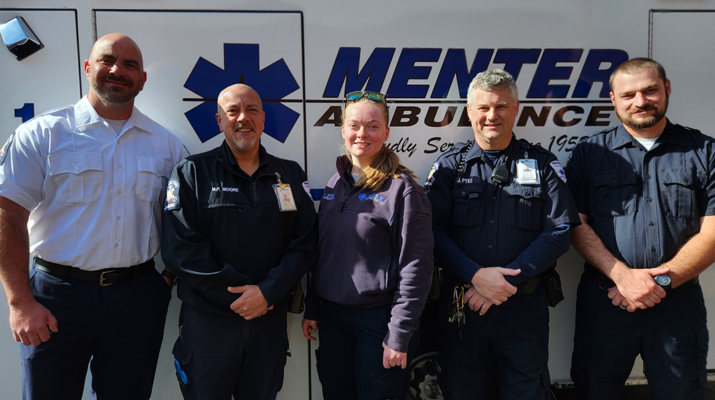By Norah Machia
Smaller hospitals in Upstate New York transfer about 8,000 patients a year to larger hospitals, mainly in Syracuse. A grant from Upstate Foundation will help ambulance companies transfers these patients more efficiently
Across New York State, first responders are traveling greater distances to transfer critically ill patients from community hospitals to those offering higher levels of care.
That includes ambulance services from the many counties surrounding Upstate Medical University in Syracuse, which receives approximately 8,000 patient transfers a year.
But the COVID-19 pandemic, which resulted in staffing shortages throughout the region, has made it increasingly difficult for community hospitals to help support these transports. Hospitals often provide staff to accompany critically ill patients on ambulance transfers or lend specialized medical equipment needed to care for the patient during the transport.
For example, a patient on a ventilator needing an ambulance transfer would typically have to be accompanied by a respiratory therapist, or a patient being managed with medicine infusions would usually need a registered nurse in the ambulance. Depending on the weather and the distance traveled, these hospital employees may be gone for hours.
“We’re seeing more critically ill patients from community hospitals traveling greater distances in these ambulances because tertiary hospitals are often filled to capacity,” said Douglas Sandbrook, the EMS liaison for Upstate Medical University, and director of EMS Education. “We try to keep people local, but the reality is there are finite number of beds.”
When those beds reserved for critically ill patients at Upstate are filled, ambulances transporting patients must be diverted to the next closest tertiary hospital.
To help address the situation, a new fund was established at the Upstate Foundation to assist ambulance services become more independent in the transportation of critically ill patients to Syracuse area hospitals and other facilities outside of Central New York.
A total of $35,000 in critical care transport grants was recently awarded to the following ambulance services: $12,500 each to Menter Ambulance in Oswego County and Guilfoyle Ambulance in Watertown, and $10,000 for the Gouverneur Rescue Squad.
The funding will help expand training for paramedics to provide the same level of care for patients inside their ambulances as those patients would receive in a hospital’s intensive care unit, said Sandbrook.
Ambulance services may also use the grant funding toward the purchase of specialized equipment, such as ventilators or IV infusion pumps, eliminating the need to borrow that equipment from community hospitals. Transport ventilators cost as much as $15,000, while IV infusion pumps cost approximately $2,000 each, he said.
“We identified these areas of need when speaking with ambulance services throughout Central and Northern New York,” said Sandbrook. The special fund at the Upstate Foundation was set up specifically to enhance existing or develop new critical care transport services.
Upstate Medical University “wanted to help these agencies build their own resources and give them the additional training to independently manage the patients during the transports,” said Sandbrook.
Menter Ambulance has transported critical care patients from Oswego County to tertiary hospitals in Syracuse for years, but the hospital staffing shortages resulting from the COVID-19 pandemic prompted the organization to further develop its critical care transport service, said Joseph Provost, public information officer at Menter Ambulance.
The private ambulance service has six paramedics on staff who have earned the critical care paramedic or the flight paramedic designations, and plans another critical care training program in the future for a new group of paramedics, he said.
“Oswego County has a strong health care system, but not all patients can be treated at a community hospital,” said Provost. “The COVID-19 pandemic has shown that is not practical for community hospitals, such as Oswego Hospital, to spare the necessary staff needed to accompany these patients.”
Prior to the COVID-19 pandemic, the majority of patient transfers from Oswego Hospital were to Syracuse, approximately 40 miles away. Since the pandemic, the ambulance service has been transporting patients to destinations farther away, such as Rochester and Albany, he said. These transports have taken staff away from the hospital for several hours at a time.
The Upstate Foundation grant will allow Menter Ambulance to provide the additional training for paramedics, and will also be used toward the purchase of specialized medical equipment. The ambulance service is working toward outfitting a new vehicle with items such as a ventilator, medical infusion pump and ultrasound machine.
This type of equipment would allow the critical care transport team “to be completely self-sufficient in providing transfer services to patients at Oswego Hospital, without the need of additional hospital staff to accompany these patients during transport,” said Provost.
For many years, “the primary transport method of critically ill or injured patients from Oswego Hospital to the regional centers in Syracuse was dependent almost exclusively on air transport,” he added. But that service is not always available, especially during the winter months when poor weather conditions make it difficult for these flights to take off.
For information about supporting this new fund at the Upstate Foundation, visit www.upstatefoundation.org.

